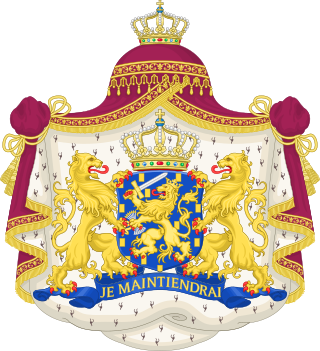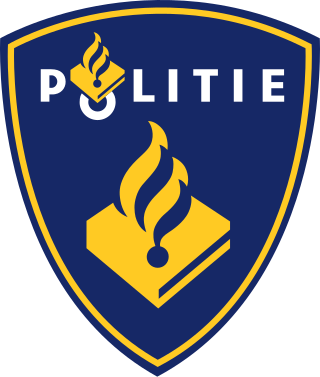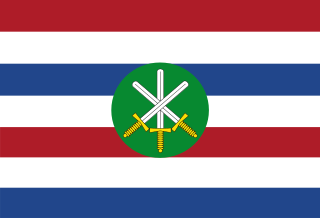
The Netherlands Armed Forces are the military forces of the Kingdom of the Netherlands. The armed forces consist of four service branches: the Royal Netherlands Navy, the Royal Netherlands Army, the Royal Netherlands Air Force and the Royal Netherlands Marechaussee. The service branches are supplemented by various joint support organizations. In addition, local conscript forces exist on the Dutch Caribbean islands of Aruba and Curaçao. These operate under the auspices of the Royal Netherlands Navy and the Netherlands Marine Corps. The armed forces are part of the Ministry of Defence.

Willem-Alexander is King of the Netherlands, reigning since 30 April 2013.
Defense on Aruba is the responsibility of the Kingdom of the Netherlands. The Netherlands Military forces that protect Aruba include the Royal Netherlands Navy, the Netherlands Marine Corps and the Dutch Caribbean Coast Guard. There is also a small indigenous militia of about platoon strength.
Marshal is a term used in several official titles in various branches of society. As marshals became trusted members of the courts of Medieval Europe, the title grew in reputation. During the last few centuries, it has been used for elevated offices, such as in military rank and civilian law enforcement.

A gendarmerie is a military force with law enforcement duties among the civilian population. The term gendarme is derived from the medieval French expression gens d'armes, which translates to "men-at-arms". In France and some Francophone nations, the gendarmerie is a branch of the armed forces that is responsible for internal security in parts of the territory, with additional duties as military police for the armed forces. It was introduced to several other Western European countries during the Napoleonic conquests. In the mid-twentieth century, a number of former French mandates and colonial possessions adopted a gendarmerie after independence.

The Military William Order, or often named Military Order of William, is the oldest and highest honour of the Kingdom of the Netherlands. It is named after St. William of Gellone (755–814), the first Prince of Orange. Its motto is Voor Moed, Beleid en Trouw. The chivalric order was established on 30 April 1815 by King William I and was presented for feats of excellent bravery on the battlefield and as a meritorious decoration to senior military officers. Comparable with the French Légion d’Honneur but far less often awarded, it is open to everyone regardless of rank or nobility—not only to Dutch military, but also to foreigners. To date, membership in the Order is extremely rarely awarded, and only for exceptional bravery in battle.

The Royal Marechaussee also translated as the Royal Military Constabulary, is the national gendarmerie force of the Netherlands, performing military and civilian police duties. It is also one of the two national police forces in the Netherlands, alongside the National Police Corps, and is one of the four branches of the Netherlands Armed Forces.

The Royal Military Academy is the service academy for the Dutch Army, the Dutch Air Force and the Royal Marechaussee. Located in Breda, Southern Netherlands, the KMA has trained future officers since 1828.

The Brigade Speciale Beveiligingsopdrachten (BSB) is the elite police tactical unit of the Royal Netherlands Marechaussee. Its missions include counter-terrorism, protection of government and military officials, and targeting organised crime.

The National Gendarmerie is one of two national law enforcement forces of France, along with the National Police. The Gendarmerie is a branch of the French Armed Forces placed under the jurisdiction of the Ministry of the Interior, with additional duties from the Ministry of Armed Forces. Its responsibilities include policing smaller towns, suburbs and rural areas, crowd and riot control, and criminal investigation, including cybercrime. By contrast, the National Police is a civilian law enforcement agency that is in charge of policing cities and larger towns. Because of its military status, the Gendarmerie also fulfills a range of military and defence missions. The Gendarmerie has a strength of around 102,269 people.

The Dienst Speciale Interventies, commonly abbreviated DSI, is the elite police tactical unit of the Dutch National Police Corps and was formally established on 1 July 2006. The DSI is tasked with neutralizing terrorist incidents and other violent public order disruptions for which regular police units are inadequately equipped. In total, the DSI consists of about 600 active personnel.

The Ministry of Defence is the Dutch ministry responsible for the armed forces of the Netherlands and veterans' affairs. The ministry was created in 1813 as the Ministry of War and in 1928 was combined with the Ministry of the Navy. After World War II in the ministries were separated again, in this period the Minister of War and Minister of the Navy were often the same person and the state secretary for the Navy was responsible for daily affairs of the Royal Netherlands Navy. In 1959 the ministries were merged once again. The ministry is headed by the Minister of Defence, currently Ruben Brekelmans, assisted by the Chief of the Defence, Onno Eichelsheim.
Michael Anthony Phelan, a senior Australian law enforcement officer, is the Chief Executive Officer of the Australian Criminal Intelligence Commission and Director of the Australian Institute of Criminology since November 2017.

The following outline is provided as an overview of and topical guide to the Netherlands.

National Police Corps, colloquially in English as Dutch National Police or National Police Force, is divided in ten regional units, two national units, the police academy, police services center, and national dispatch center cooperation. The law-enforcement purposes of these agencies are the investigation of suspected criminal activity, referral of the results of investigations to the courts, and the temporary detention of suspected criminals pending judicial action. Law enforcement agencies, to varying degrees at different levels of government and in different agencies, are also commonly charged with the responsibilities of deterring criminal activity and preventing the successful commission of crimes in progress. The police commissioner in the Netherlands is Janny Knol since March 1, 2024.

The Caribbean Netherlands is a geographic region of the Netherlands located outside of Europe, in the Caribbean, consisting of three special municipalities. These are the islands of Bonaire, Sint Eustatius, and Saba, as they are also known in legislation, or the BES islands for short. The islands are officially classified as public bodies in the Netherlands and as overseas territories of the European Union; as such, European Union law does not automatically apply to them.

The Chief of Defence is the highest-ranking officer in the Netherlands Armed Forces and is the principal military advisor to the minister of defence. On behalf of the minister of defence, he is responsible for operational policy, strategic planning and for preparing and executing military operations carried out by the armed forces. The chief of defence is in charge of the central staff and is the direct commanding officer of all the commanders of the branches of the armed forces. In this capacity, the chief of defence directs all the activities of the Royal Netherlands Army, the Royal Netherlands Navy and Royal Netherlands Air Force. He is also in charge of the Royal Netherlands Marechaussee, when it is operating under the guise of the minister of defence.

The Marechaussee Museum or Royal Marechaussee Museum is a museum on the history of the Royal Marechaussee of the Netherlands from its foundation by William I of the Netherlands on 26 October 1814 until the present day. It is based in the former Koninklijk Weeshuis in Buren, originally opened as an orphanage on 26 May 1612 by Maria van Nassau and remaining in that role until 1953.
The Maréchaussée were corps of soldiers in the armies of France initially put in charge of military policing and justice during the Middle Ages, and later extended to civilian responsibilities. They gradually coalesced into a police force with jurisdiction over the whole population on almost the entire territory of France. They retained powers of extraordinary justice until the French Revolution.















